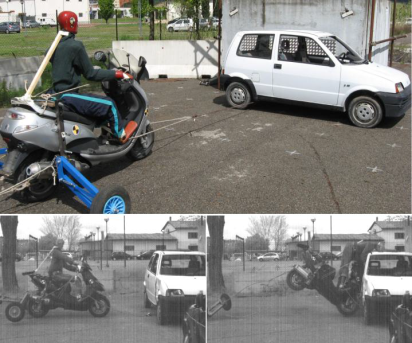More information
Main author
Vangi, D.
Co-Authors
Begani, F.; Cialdai, C.; Virga, A.
Type of media
Publication type
Lecture
Publication year
2013
Publisher
22. EVU Conference, Florence
Citation
Vangi, D.: Motorcycle to Car Collisions: Evaluation of Energy Loss and Relative Impact Velocity
 In this paper an analysis of collisions between motorcycles and cars is presented, with the limitation that the motorcycle is involved in its frontal part, with wheelbase shortening. The work focuses on finding an empirical formulation for the relative velocity, allowing for the presence of the motorcycle's rider at the moment of collision. In addition, attention is givent to the crash energy loss evaluation, which is an essential parameter for estimating the relative velocity of the vehicles. Often in this field, as is remarked upon in technical literature, the main difficulty lies in the evaluation of the energy loss for the car, on which localised deformations are usually produced, involving zones, for example near the wheels, which have a stiffness completely different from those areas on which crash tests are normally carried out. In this paper a simplified equation for calculating impact relative velocity is presented, which is applicable in the case where the motorcycle driver is still on his vehicle, that is to say when three different bodies are present (rider, motorcycles, car), each characterised by its post-collision motion. Motorcycle to vehicle crash tests carried out, highlight that with the formulation here proposed a good estimation of relative velocity can be obtained. In addition, a semi-empirical approach is introduced for the evaluation of the kinetic energy lost by the two vehicles in the collision. when the front part of the motorcycle is involved in the collision. It aims at providing a method for calculation that, unlike those already presented in technical literature, is independent of the zone of the car involved in the impact.
In this paper an analysis of collisions between motorcycles and cars is presented, with the limitation that the motorcycle is involved in its frontal part, with wheelbase shortening. The work focuses on finding an empirical formulation for the relative velocity, allowing for the presence of the motorcycle's rider at the moment of collision. In addition, attention is givent to the crash energy loss evaluation, which is an essential parameter for estimating the relative velocity of the vehicles. Often in this field, as is remarked upon in technical literature, the main difficulty lies in the evaluation of the energy loss for the car, on which localised deformations are usually produced, involving zones, for example near the wheels, which have a stiffness completely different from those areas on which crash tests are normally carried out. In this paper a simplified equation for calculating impact relative velocity is presented, which is applicable in the case where the motorcycle driver is still on his vehicle, that is to say when three different bodies are present (rider, motorcycles, car), each characterised by its post-collision motion. Motorcycle to vehicle crash tests carried out, highlight that with the formulation here proposed a good estimation of relative velocity can be obtained. In addition, a semi-empirical approach is introduced for the evaluation of the kinetic energy lost by the two vehicles in the collision. when the front part of the motorcycle is involved in the collision. It aims at providing a method for calculation that, unlike those already presented in technical literature, is independent of the zone of the car involved in the impact.